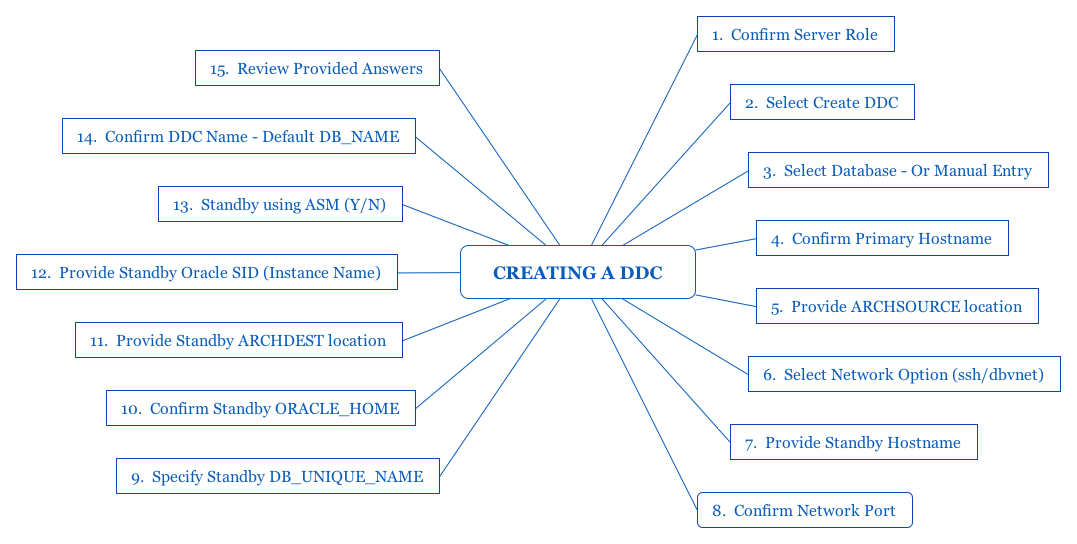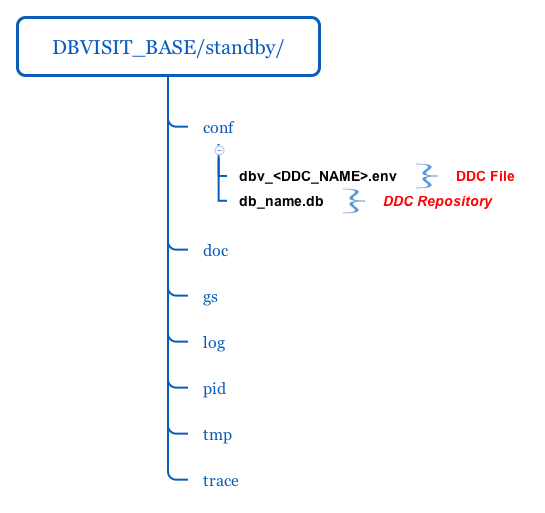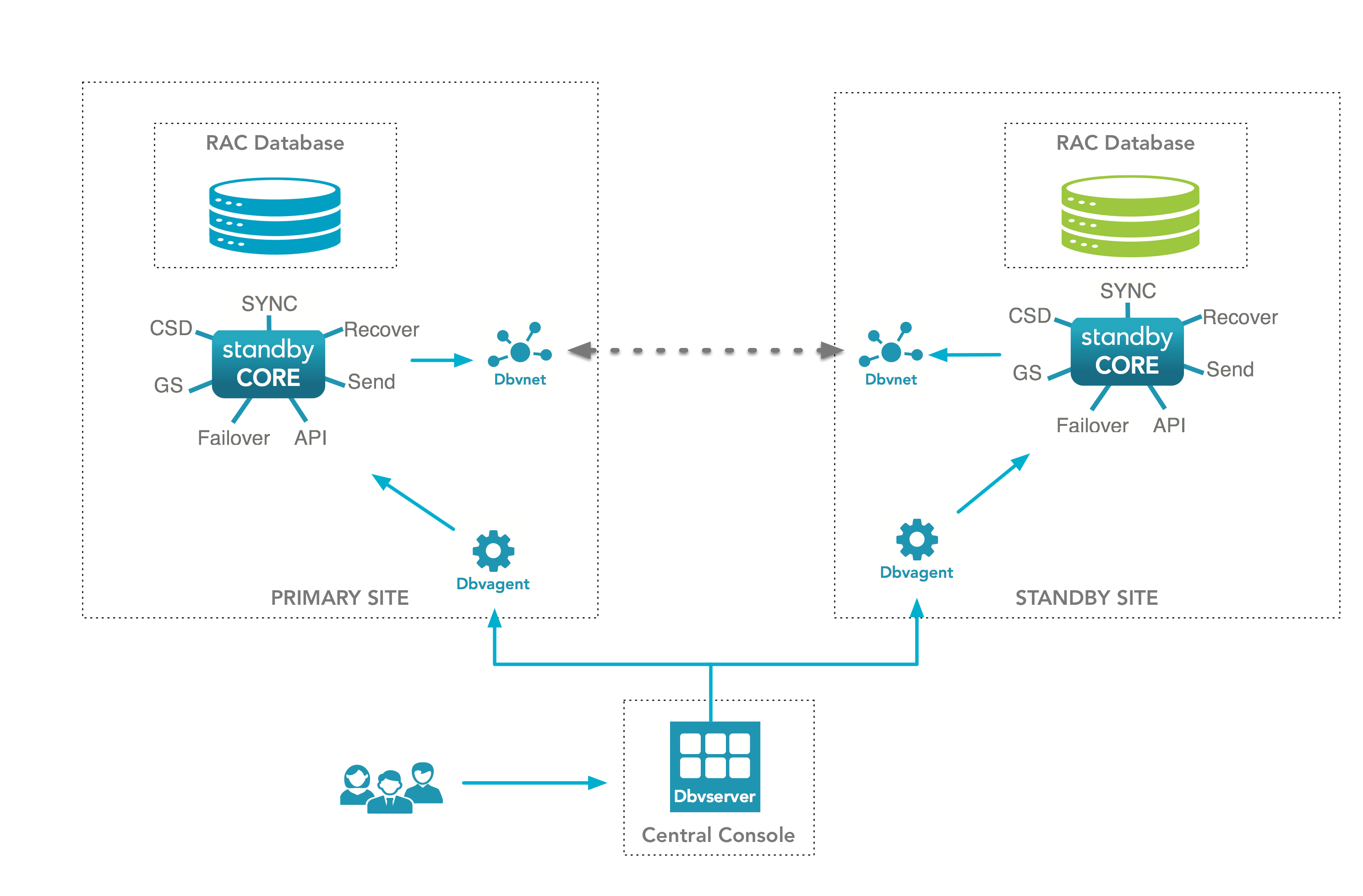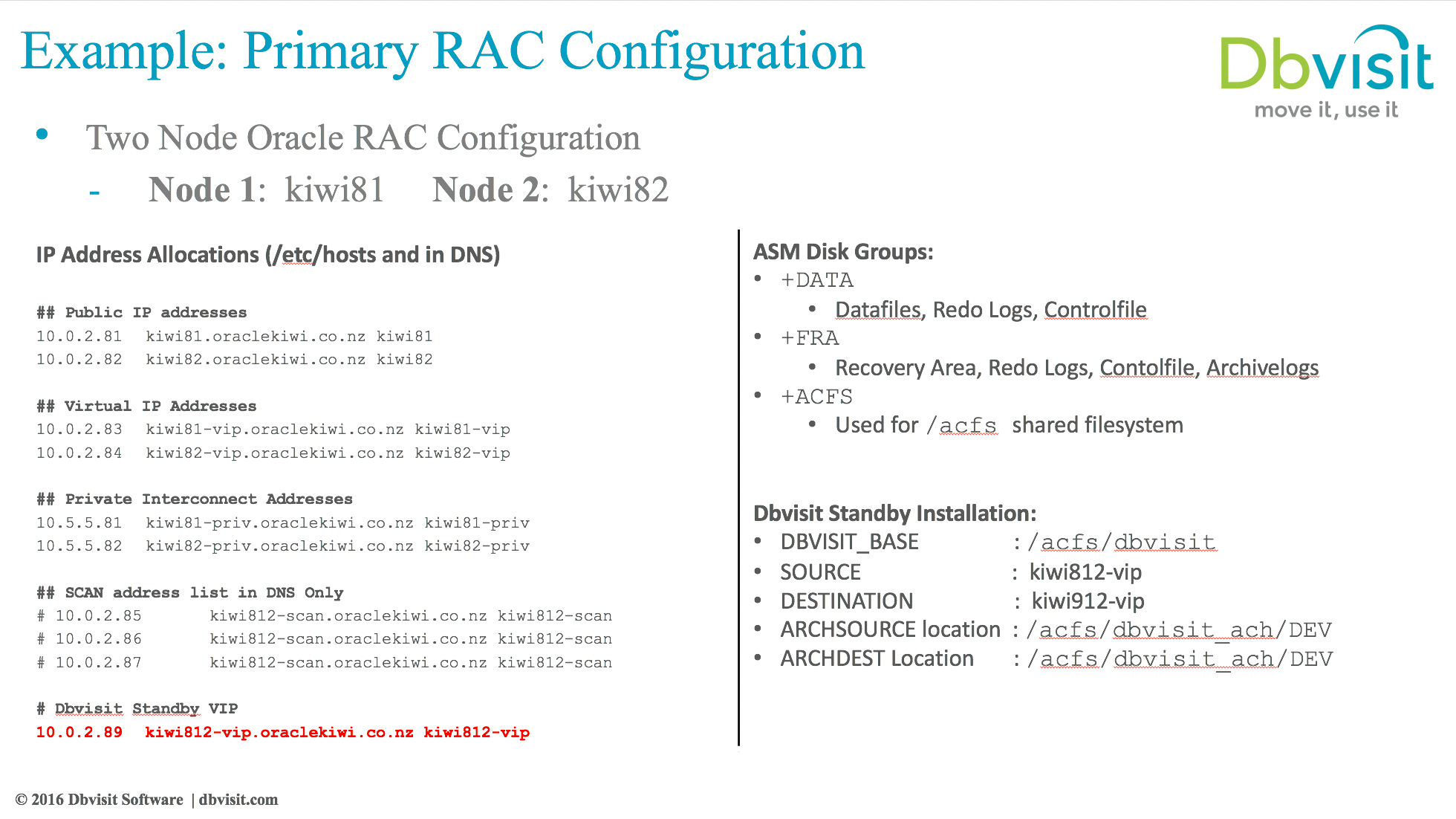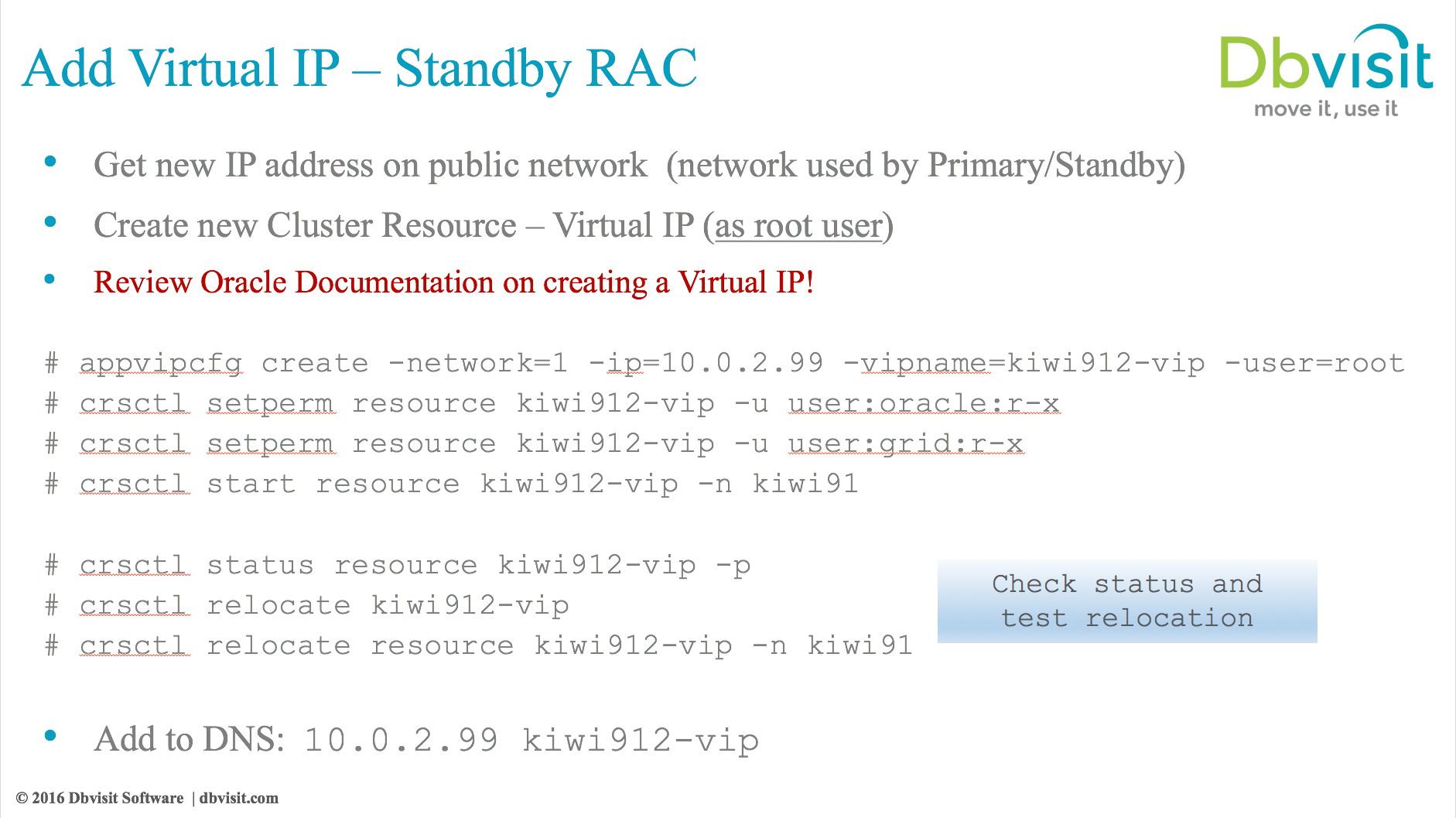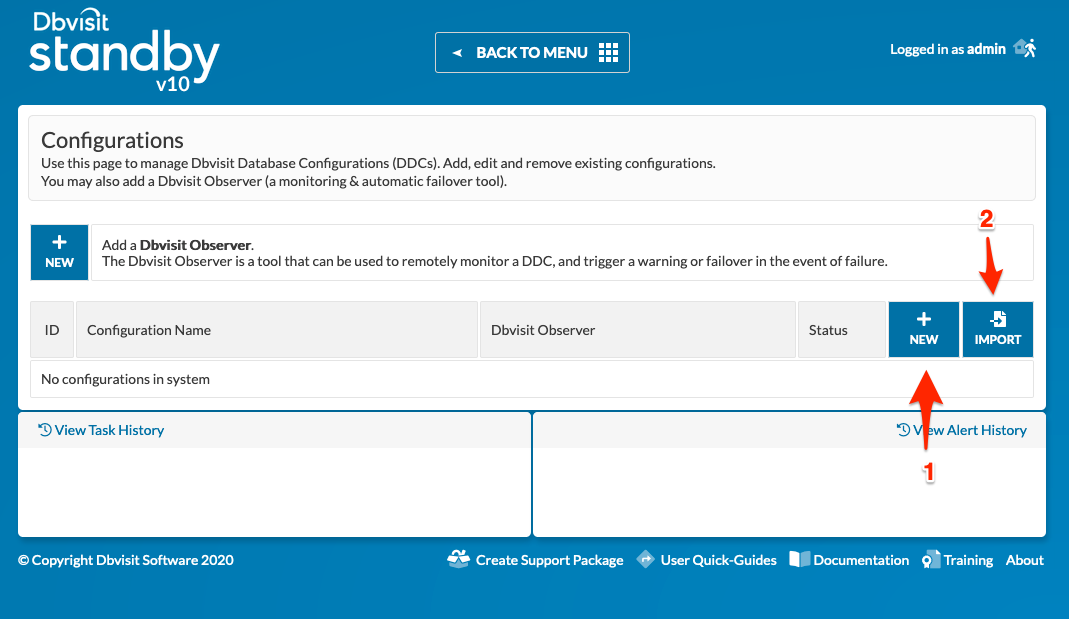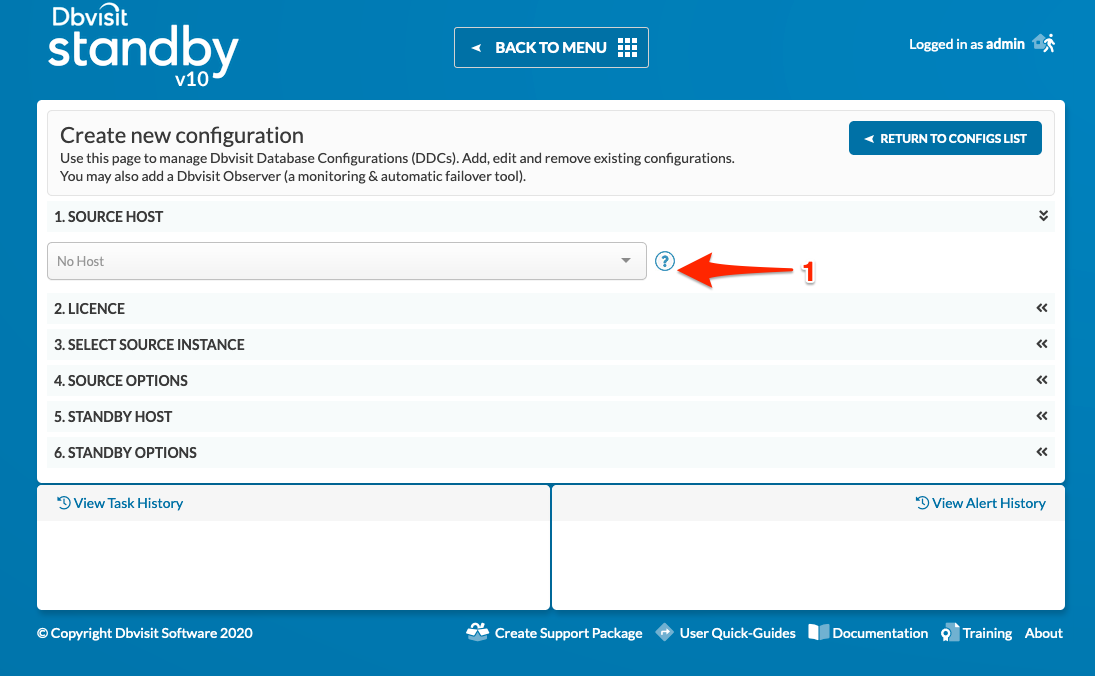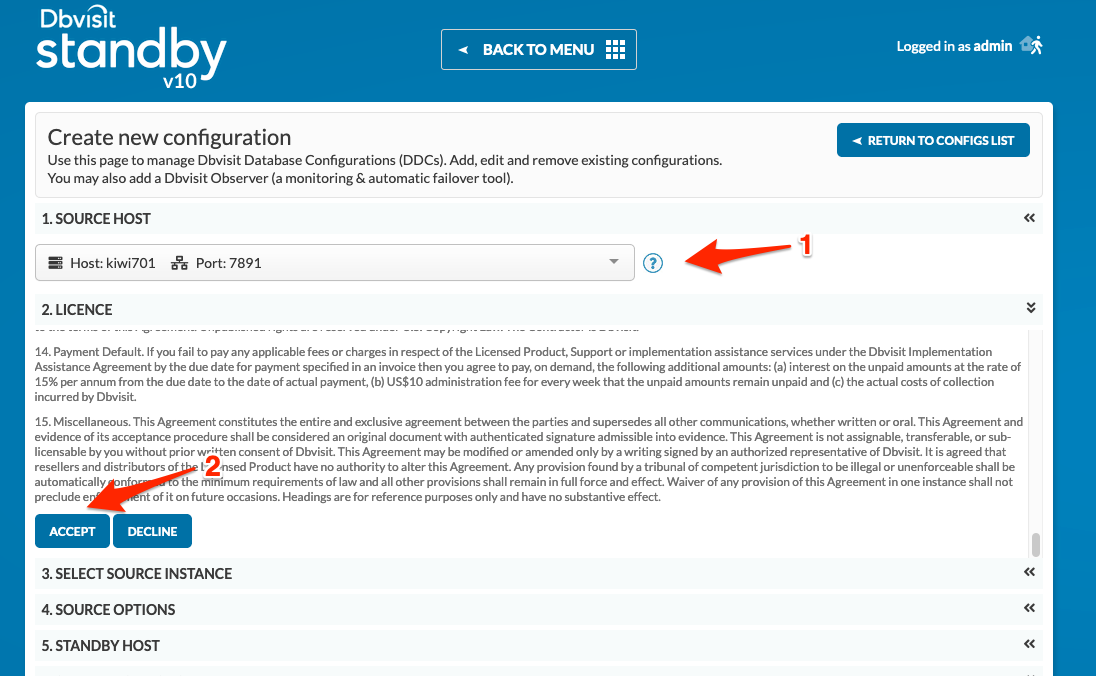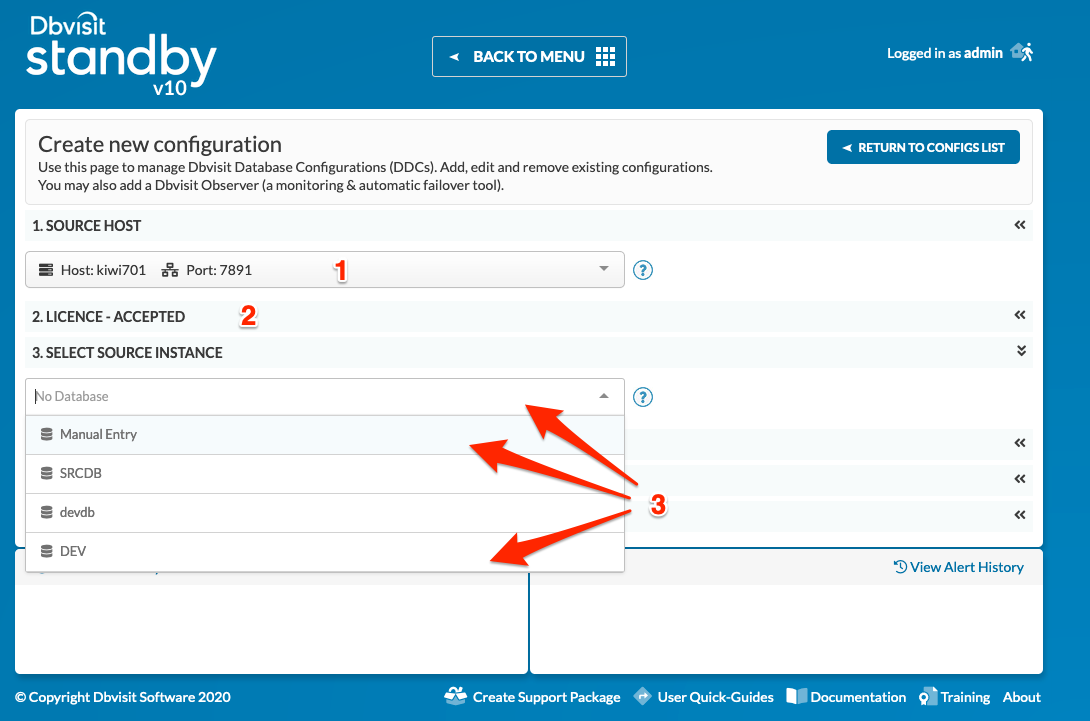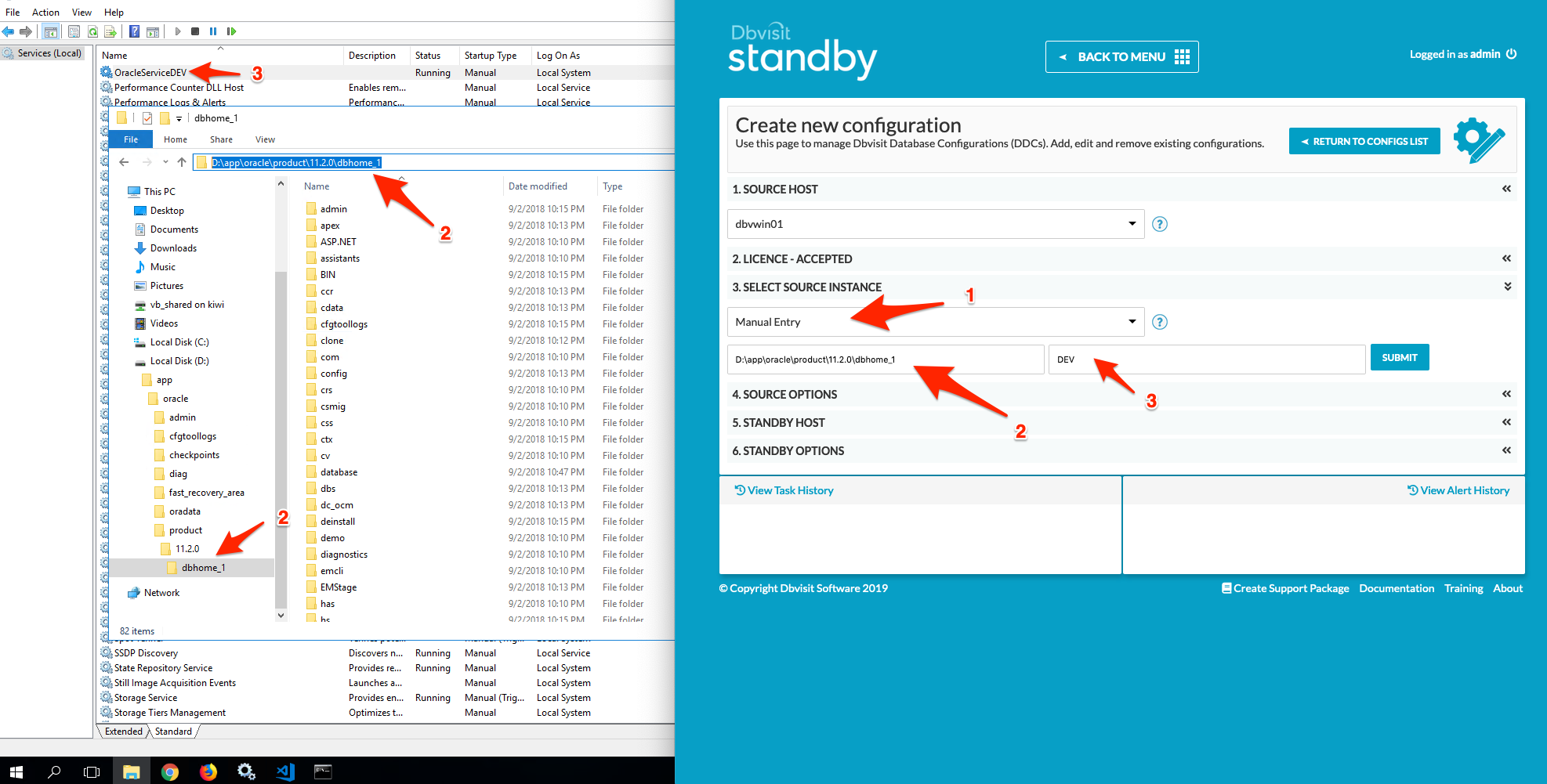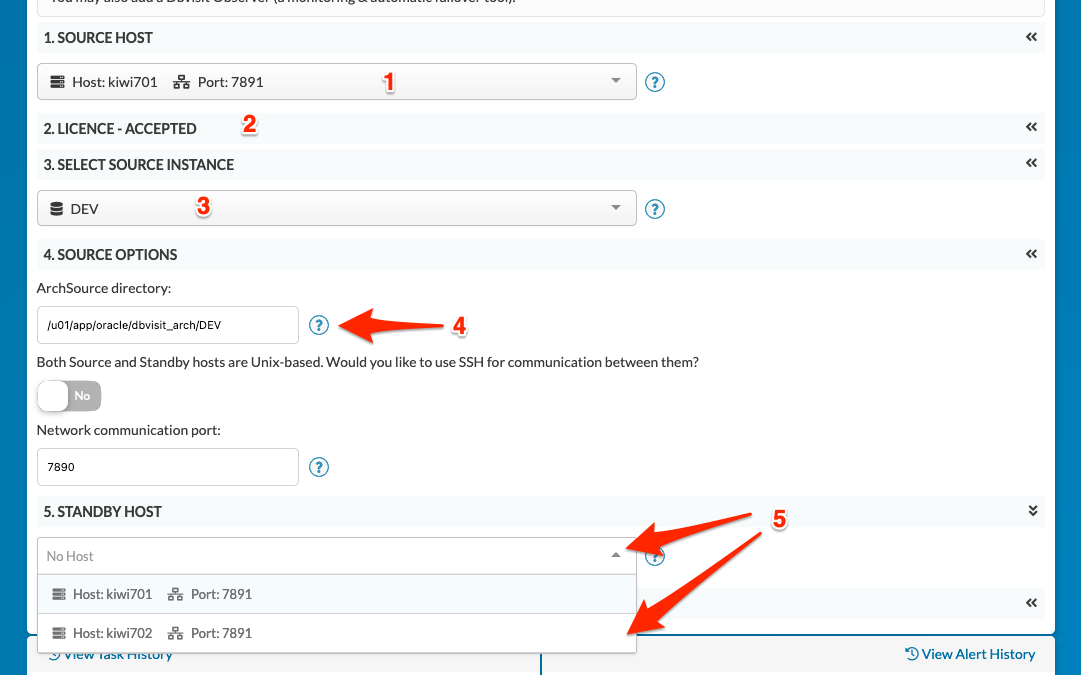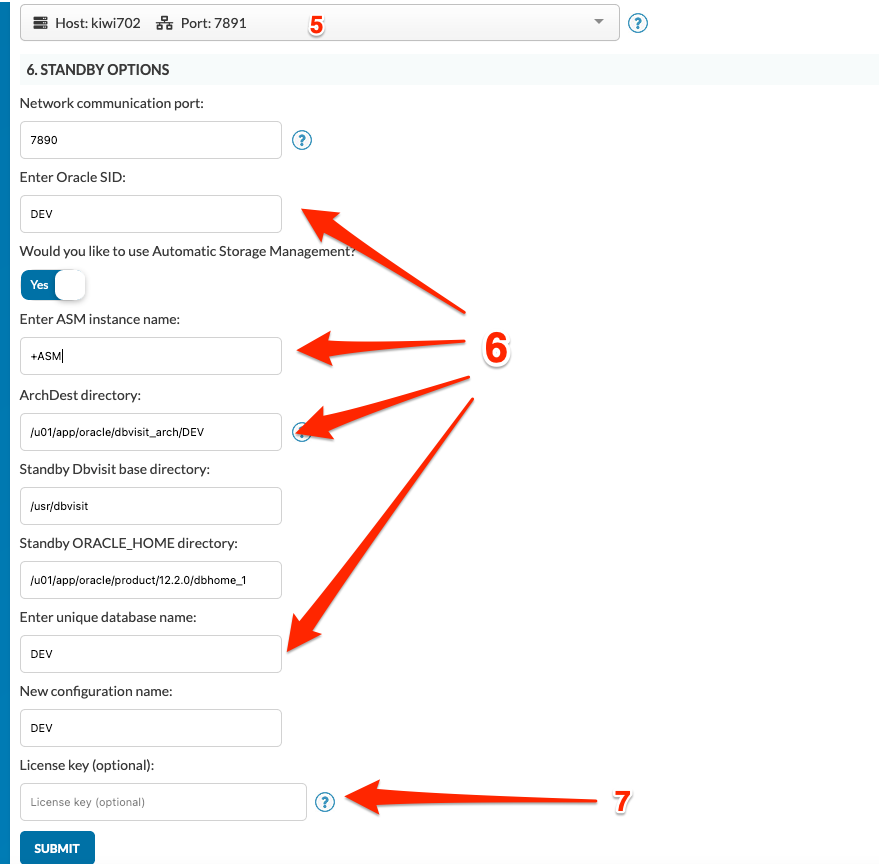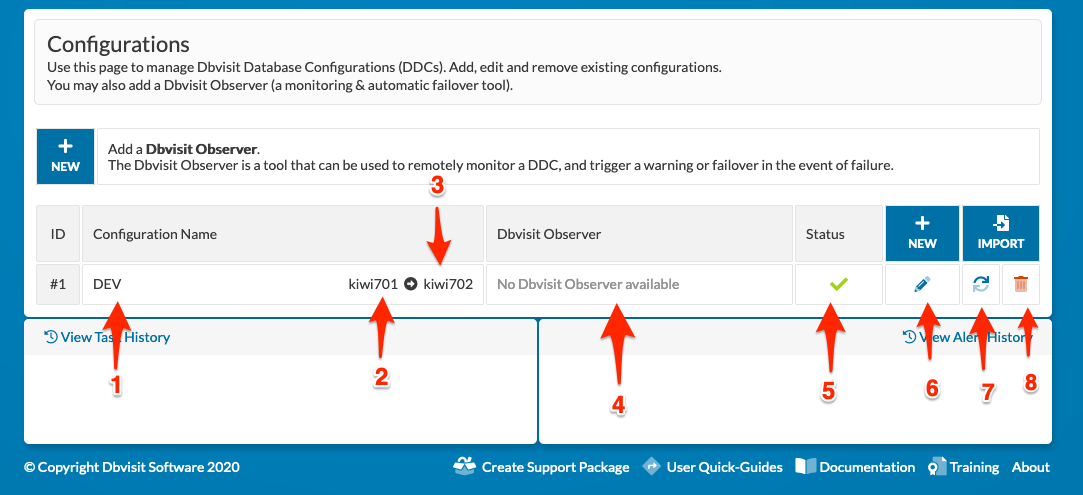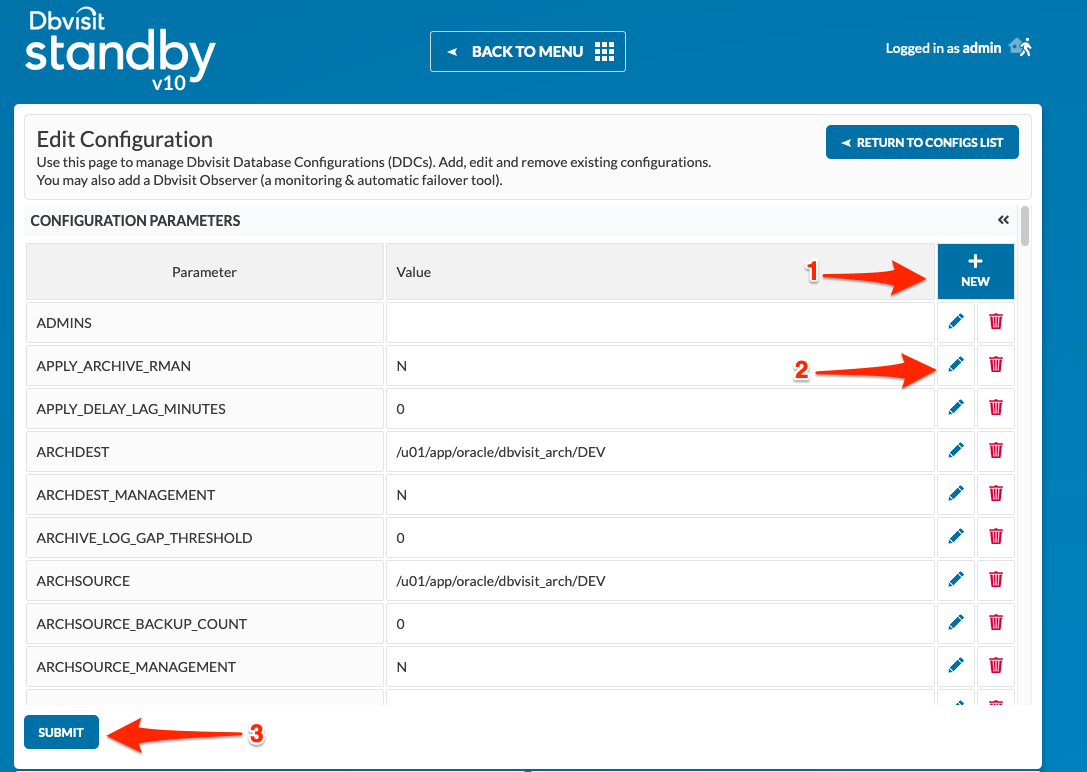Creating the DDC File
1. Introduction
In this section, we will cover the creation of a new Dbvisit Standby Configuration, also known as creating a Dbvisit Database Configuration (DDC) file.
It is important that before you continue with these sections that you make sure the following pre-requisites have been performed:
- Operating Systems are compatible
- It is recommended that the primary and standby server operating systems match
- Oracle Database Software is installed on both the primary and standby database servers
- The Oracle Database software must use the same Edition - mixing editions is not recommended. Using a combination of Standard and Enterprise Edition is not supported.
- You have a Primary Database already configured and it is open read/write and fully functional
- If you are using Oracle RAC, when installing and configuring Dbvisit Standby, it is recommended at the point of installation and configuration that all nodes on the Primary database be fully functional and that all instances are open and running.
- If you are using Oracle RAC:
- Shared storage is highly recommended for:
- Dbvisit Standby Installation (Dbvisit Base)
- Dbvisit Standby ARCHDEST and ARCHSOURCE locations
- Shared storage is highly recommended for:
On this page:
- Dbvisit Standby is already installed on both primary and standby database servers
- Dbvnet must be configured for communication between the primary and standby servers
- If you are using UNIX based systems, you are allowed to use SSH instead of Dbvnet - this is fully supported.
- If using SSH it must be configured for password-less authentication (SSH user equivalence) without a passphrase
- The Dbvisit Agent (dbvagent) must be installed on both the primary and standby servers
For more detail on the pre-requisite steps please see System Requirements
Dbvisit Standby version 10.0.x allows you to create a DDC (Dbvisit Standby configuration file) for the following scenarios:
- Oracle single instance database as primary with a single instance database as a standby
- The primary and standby databases can use Filesystem based storage or ASM
- If ASM is to be used on the standby it must already be configured with the required disk groups
- Primary and Standby database systems should match - especially the Oracle Database software (Including patch levels)
- Mixing Database Editions are not supported. Both primary and standby must use the same Oracle Software version and Edition.
- Oracle Real Application Cluster (RAC) database as primary to a single instance standby database (with multiple threads but only one is used)
- Oracle Real Application Cluster (RAC) database as primary with an Oracle RAC database as a standby
If using Oracle RAC configurations:
- The primary and standby configuration should match (Operating System, Clusterware - GI, and Database software)
- If the primary is a two-node cluster the standby Oracle RAC must also be a two-node cluster
- All RAC nodes must be running at the time of running the Dbvisit Standby - Create Standby Database option
- A Virtual IP address and name is recommended for each cluster
- If the Standby Database is to be an Oracle RAC enabled cluster, the Oracle RAC cluster must already be configured with the required disk groups and storage available.
- If using Oracle RAC, it is recommended to have a shared storage location for the Dbvisit Standby installation as well as for the Dbvisit ARCSOURCE and ARCHDEST locations. These locations are used by Dbvisit and are not the same as the database archive destinations and should not be located inside the database archive log destination or fast/flash recovery area.
2. Creating a Dbvisit Standby Configuration (DDC) File - Command Line
In this section of the documentation, we will focus on the creation of the DDC file using the Command Line Interface (CLI).
There will be three sections to this:
- Creating a DDC Using non-ASM based database storage
- Creation of a DDC using ASM based storage
When using Dbvisit Standby version 10 Grid Infrastructure (ASM) configurations must be Oracle 11.2 and above - with the latest patch set recommended.
Using versions less than 11.2 is not supported for ASM configurations.
Below is a diagram providing an overview of the questions that will be asked when creating a new basic NON-RAC DDC file using the "dbvctl -o setup" command option (review clockwise):
It is important that before you continue with these sections that you make sure the pre-requisites have been performed.
2.1. Creating a DDC - Using Filesystem Based Storage
To create a DDC file from the command line interface you will be using the “dbvctl -o setup” command.
Below is a summary of the environment that will be used in this example:
- This environment will not be using ASM for database storage
- Primary Server: dbv1
- Standby Server: dbv2
- Primary Database Name: DEV
- Primary Database Unique Name: DEV
- Standby Database Unique Name and SID will be the same: DEV
- Dbvnet will be used for network communication
- Dbvnet default PORT of 7890 will be used
- Dbvisit Standby ARCHSOURCE location on the primary server: /u01/app/oracle/dbvisit_archdest/DEV
- Dbvisit Standby ARCHDEST location on standby server: /u01/app/oracle/dbvisit_archdest/DEV
- The Dbvisit Base directory is /usr/dbvisit
- Dbvisit Standby is already installed on both the primary and standby servers
Note that this example is for a single instance environment and not for an Oracle RAC configuration
The following questions will be asked during the configuration steps:
- Confirmation that you are running this on the primary server (creating a DDC file on the Standby server is only possible if you use the cascading standby database option)
- Selecting the option from the menu - running "dbvctl -o setup" without any further parameters will open a menu with two options. To continue and create the DDC or to cancel and exit.
- A list of Databases detected on the system (using the Oracle /etc/oratab file entries) will be provided. You can now either select the primary database for which you want to create a DDC for, or you can add your own manually. It is recommended to make use of the Oracle-supplied /etc/oratab files and make sure your Oracle databases are listed including the Oracle software home they belong too.
- Once the database is selected, the next question will confirm the hostname. It is possible that the hostname is different than the actual hostname. It might be that you have multiple network interfaces configured for the server and that you would like to use a specific interface or hostname to be used for the Dbvisit Standby configuration. By default, the output of the "hostname" command will be used. If required please adjust this value the correct name of the primary host.
- The next question is to obtain the Dbvisit Standby ARCHSOURCE location. This is the location on the Primary server and is used for storing archive logs once the server becomes a standby database (following a Graceful Switchover). It is not strictly required, but having the ARCHDEST and ARCHSOURCE folder structure the same is recommended. These directories may exist prior to running the setup command to create the DDC - if not they will be created as part of the DDC creation.
- When using UNIX based systems SSH or DBVNET can be used for network communication. If the setup detects you are using UNIX, you will be asked if you want to configure Dbvisit Standby to use SSH - if you specify YES to this question, SSH will be used. You will need to make sure that SSH authentication between primary and standby servers are already configured to use passwordless authentication.
- Once the network communication option is specified you will be asked to supply the Destination hostname (The standby database server).
- The next question is to specify the network port to be used for communication between the primary and standby database servers. This is the port used by DBVNET or SSH. For Dbvnet the default port is 7890 and for SSH it is 22.
- The standby database DB_UNIQUE_NAME value is requested. The default value is the same as the primary database, but this value might be different if required. The recommendation is to use the default supplied value. If you have multiple standby databases for the same primary database, using different DB_UNIQUE_NAME values for the standby databases are recommended.
- The Oracle Home path for the Standby server should be supplied as the answer to question eight. The Oracle Database Software must be installed on the standby server prior to starting the Dbvisit Standby installation and configuration
- Confirm the ARCHDEST location - see 5 above. The ARCHDEST location is the location on the standby server where the archive logs will be copied to. This directory must exist and there must be sufficient storage capacity to hold at least one days worth of archive logs (3 days are recommended)
- The Oracle SID should be supplied for the standby database. This will be the Database Instance name on the standby server.
- One of the final questions is to confirm if the standby database will be using ASM for database storage. By default, this value is empty - indicating that ASM will not be used. If this is correct, accept the default and continue with an empty value selected.
- The name of the DDC is confirmed - the default value is the same as the DB_NAME on the primary database. Using the default value is recommended.
- The final step is a listing of the answers provided to the above questions. If all is in order continue by accepting the values. The DDC file will be created together with the Dbvisit Standby repository which will hold internal information used by Dbvisit Standby. These files are created in the DBVISIT_BASE/standby/conf directory. In this example they are:
- dbv_DEV.env (The DDC File)
- qa.db (The Dbvisit Standby repository for the DEV DDC configuration
- There is also an option to provide the license key while creating the DDC, but this is optional you can provide the license key even after creating the DDC but you need to update the configuration with a license before proceeding to the create the standby database.
The end result of the above is that you will have a new DDC file and Repository as illustrated in the diagram below:
Below is an example of the described steps above to create the DDC file called dbv_DEV.env and repository dev.db in /usr/dbvisit/standby/conf/
[oracle@dbv1 standby]$ ./dbvctl -o setup
=========================================================
Dbvisit Standby Database Technology (10.0.0RC_15_g81628a5f)
http://www.dbvisit.com
=========================================================
=>dbvctl only needs to be run on the primary server.
Is this the primary server? <Yes/No> [Yes]:
The following Dbvisit Database configuration (DDC) file(s) found on this
server:
DDC
===
1) Create New DDC
2) Cancel
Please enter choice [] : 1
Is this correct? <Yes/No> [Yes]:
END USER LICENSE AGREEMENT
PLEASE READ THIS END USER LICENSE AGREEMENT (AGREEMENT) CAREFULLY BEFORE
DOWNLOADING THE LICENSED PRODUCT. BY CLICKING I AGREE BELOW, YOU ARE
REPRESENTING THAT YOU HAVE THE RIGHT AND AUTHORITY TO LEGALLY BIND YOURSELF
OR YOUR COMPANY, AS APPLICABLE AND YOU ARE AGREEING TO BE BOUND BY THE
TERMS AND CONDITIONS OF THIS AGREEMENT, THE SUPPORT AGREEMENT AND THE
....
.... for this example the full license have been removed, but the full license agreement should be reviewed before you continue.
....
....
by a tribunal of competent jurisdiction to be illegal or unenforceable
shall be automatically conformed to the minimum requirements of law and
all other provisions shall remain in full force and effect. Waiver of any
provision of this Agreement in one instance shall not preclude enforcement
of it on future occasions. Headings are for reference purposes only and
have no substantive effect.
Continue ? <Yes/No> [No]: Yes
=========================================================
Dbvisit Standby setup begins.
=========================================================
The following Oracle instance(s) have been found on this server:
SID ORACLE_HOME
=== ===========
1) DEV /u01/app/oracle/product/11.2.0.4/dbhome_1
2) Enter own ORACLE_SID and ORACLE_HOME
Please enter choice [] : 1
Is this correct? <Yes/No> [Yes]:
=>ORACLE_SID will be: DEV
=>ORACLE_HOME will be: /u01/app/oracle/product/11.2.0.4/dbhome_1
------------------------------------------------------------------------------
Enter the primary server name.
Note: The hostname is case sensitive on UNIX based systems.
=>SOURCE is [dbv1]:
Your input: dbv1
Is this correct? <Yes/No> [Yes]:
Choice is dbv1
------------------------------------------------------------------------------
Please enter a filesystem directory that Dbvisit Standby use to store (archive)
log files. This directory is not the same as the database recovery area or
archive destinations and should not be located in these areas.
The ARCHSOURCE directory is located on the primary server and will become the
ARCHDEST location when the primary database is converted to a standby database
during a Graceful Switchover operation.
This directory will ONLY contain (archive) log files related to this database.
It should not contain any other (non archive log) files.
Please ensure that this directory exists on
=>ARCHSOURCE is [/u01/app/oracle/dbvisit_arch/DEV]:
Your input: /u01/app/oracle/dbvisit_arch/DEV
Is this correct? <Yes/No> [Yes]:
Choice is /u01/app/oracle/dbvisit_arch/DEV
------------------------------------------------------------------------------
Do you want to use SSH to connect to the standby server? Note that if you are
using SSH, passwordless SSH authentication between the hosts must already be
configured. By default Dbvnet will be used.
=>USE_SSH is [N]:
Your input: N
Is this correct? <Yes/No> [Yes]:
Choice is N
------------------------------------------------------------------------------
Specify the DBVNET or SSH port number on the primary server. The default value
supplied is the dbvnet port 7890. If you specified the use of SSH, please
specify the SSH port here.
=>NETPORT is [7890]:
Your input: 7890
Is this correct? <Yes/No> [Yes]:
Choice is 7890
------------------------------------------------------------------------------
Enter the standby database hostname.
If the standby database will be Oracle RAC enabled:
Enter the the Virtual Hostname (linked to a Virtual IP) for standby database.
This virtual hostname is attached to a VIP that will be able to move between
the RAC nodes. Dbvisit Standby will only run on the server where this virtual
hostname (VIP) resource is running.
The Virtual Hostname (and VIP) should be configured as a resouce in clusterware
and must be enabled and started on one of the nodes before yo continue with the
setup. If you are not using a Virtual Hostname (Highly Recommended), Dbvisit
Standby can only be configured to run on one dedicated node in the RAC
configuration - specify the hosts name here if you do not have a Virtual
Hostname (attached to VIP) for the cluster configured.
For non-RAC configurations specify the standby database server name here.
=>DESTINATION is []: dbv2
Your input: dbv2
Is this correct? <Yes/No> [Yes]:
Choice is dbv2
------------------------------------------------------------------------------
Specify the DBVNET or SSH port number on the standby server. The default value
supplied is the dbvnet port 7890. If you specified the use of SSH, please
specify the SSH port here.
=>NETPORT_DR is [7890]:
Your input: 7890
Is this correct? <Yes/No> [Yes]:
Choice is 7890
------------------------------------------------------------------------------
Enter Dbvisit Standby installation directory on the standby server
=>DBVISIT_BASE_DR is [/usr/dbvisit]:
Your input: /usr/dbvisit
Is this correct? <Yes/No> [Yes]:
Choice is /usr/dbvisit
------------------------------------------------------------------------------
Enter ORACLE_HOME directory on the standby server
=>ORACLE_HOME_DR is [/u01/app/oracle/product/11.2.0.4/dbhome_1]:
Your input: /u01/app/oracle/product/11.2.0.4/dbhome_1
Is this correct? <Yes/No> [Yes]:
Choice is /u01/app/oracle/product/11.2.0.4/dbhome_1
------------------------------------------------------------------------------
Enter DB_UNIQUE_NAME on the standby server
=>DB_UNIQUE_NAME_DR is [DEV]:
Your input: DEV
Is this correct? <Yes/No> [Yes]:
Choice is DEV
------------------------------------------------------------------------------
Please enter the directory where Dbvisit Standby will transfer the (archive)
log files to on standby server. This directory is not the same as the
database recovery area or archive destinations and should not be located in
these areas.
This directory should ONLY contain (archive) log files related to this
database. It should not contain any other (non archive log) files.
Please ensure that this directory exists on the standby server
=>ARCHDEST is [/u01/app/oracle/dbvisit_arch/DEV]:
Your input: /u01/app/oracle/dbvisit_arch/DEV
Is this correct? <Yes/No> [Yes]:
Choice is /u01/app/oracle/dbvisit_arch/DEV
------------------------------------------------------------------------------
Enter ORACLE_SID on the standby server
=>ORACLE_SID_DR is [DEV]:
Your input: DEV
Is this correct? <Yes/No> [Yes]:
Choice is DEV
------------------------------------------------------------------------------
Enter ASM instance name on the standby server, if your standby is using ASM.
If you are not using ASM on the standby or standby is ACFS leave the value
null.
=>ORACLE_SID_ASM_DR is []:
Is this correct? <Yes/No> [Yes]:
Choice is null
------------------------------------------------------------------------------
Please specify the name of the Dbvisit Database configuration (DDC) file.
The DDC file is a plain text file that contains all the Dbvisit Standby
settings.
=>ENV_FILE is [DEV]:
Your input: DEV
Is this correct? <Yes/No> [Yes]:
Choice is DEV
------------------------------------------------------------------------------
Provide license key.
=>LICENSE_KEY is []: 4jo70-qwp4l-7gplh-g1cg5-lx3kf-2dcd9-1o43m
Your input: 4jo70-qwp4l-7gplh-g1cg5-lx3kf-2dcd9-1o43m
Is this correct? <Yes/No> [Yes]:
Choice is 4jo70-qwp4l-7gplh-g1cg5-lx3kf-2dcd9-1o43m
------------------------------------------------------------------------------
Below are the list of configuration variables provided during the setup
process:
Configuration Variable Value Provided
====================== ==============
ORACLE_SID DEV
ORACLE_HOME /u01/app/oracle/product/11.2.0.4/dbhome_1
SOURCE dbv1
ARCHSOURCE /u01/app/oracle/dbvisit_arch/DEV
RAC_DR N
USE_SSH N
NETPORT 7890
DESTINATION dbv2
NETPORT_DR 7890
DBVISIT_BASE_DR /usr/dbvisit
ORACLE_HOME_DR /u01/app/oracle/product/11.2.0.4/dbhome_1
DB_UNIQUE_NAME_DR DEV
ARCHDEST /u01/app/oracle/dbvisit_arch/DEV
ORACLE_SID_DR DEV
ENV_FILE DEV
LICENSE_KEY 4jo70-qwp4l-7gplh-g1cg5-lx3kf-2dcd9-1o43m
Are these variables correct? <Yes/No> [Yes]:
>>> Dbvisit Database configuration (DDC) file DEV created.
>>> Dbvisit Database repository (DDR) DEV created.
Repository Version 9.2
Software Version 9.2
Repository Status VALID
PID:233
TRACE:dbvisit_install.log
[oracle@dbv1 standby]$ ./dbvctl -V
10.0.0RC_15_g81628a5f
[oracle@dbv1 standby]$ cd conf/
[oracle@dbv1 conf]$ ls -lrt
total 188
-rw-r--r-- 1 oracle oinstall 8861 Nov 26 16:23 dbv_message.html
-rw-r--r-- 1 oracle oinstall 8872 Nov 26 16:23 dbv_error.html
-rw-r--r-- 1 oracle oinstall 28672 Nov 26 16:28 dbv_notify.db
-rw-r--r-- 1 oracle oinstall 26143 Nov 26 16:30 dbv_DEV.env
-rw-r--r-- 1 oracle oinstall 102400 Nov 26 16:30 dev.db
[oracle@dbv1 conf]$
2.2. Creating a DDC - Using ASM Based Storage
To create a DDC file from the command line interface you will be using the “dbvctl -o setup” command.
Below is a summary of the environment that will be used in this example:
- This environment will be using ASM for database storage
- Primary Server: kiwi701
- Standby Server: kiwi702
- Primary Database Name: DEV
- Primary Database Unique Name: DEV
- Standby Database Unique Name and SID will be the same: DEV
- Dbvnet will be used for network communication
- Dbvnet default PORT of 7890 will be used
- Dbvisit Standby ARCHSOURCE location on the primary server: /u01/app/oracle/dbvisit_archdest/DEV
- Dbvisit Standby ARCHDEST location on standby server: /u01/app/oracle/dbvisit_archdest/DEV
- The Dbvisit Base directory is /usr/dbvisit
- Dbvisit Standby is already installed on both the primary and standby servers
- Both Primary and Standby database servers are running Grid Infrastructure 12.2.0.1.0 and have an ASM instance named +ASM
The following questions will be asked during the configuration steps:
- Confirmation that you are running this on the primary server (creating a DDC file on the Standby server is only possible if you use the cascading standby database option)
- Selecting the option from the menu - running "dbvctl -o setup" without any further parameters will open a menu with two options. To continue and create the DDC or to cancel and exit.
- A list of Databases detected on the system (using the Oracle /etc/oratab file entries) will be provided. You can now either select the primary database for which you want to create a DDC for, or you can add your own manually. It is recommended to make use of the Oracle-supplied /etc/oratab files and make sure your Oracle databases are listed including the Oracle software home they belong too.
- Once the database is selected, the next question will confirm the hostname. It is possible that the hostname is different than the actual hostname. It might be that you have multiple network interfaces configured for the server and that you would like to use a specific interface or hostname to be used for the Dbvisit Standby configuration. By default, the output of the "hostname" command will be used. If required please adjust this value the correct name of the primary host.
- The next question is to obtain the Dbvisit Standby ARCHSOURCE location. This is the location on the Primary server and is used for storing archive logs once the server becomes a standby database (following a Graceful Switchover). It is not strictly required, but having the ARCHDEST and ARCHSOURCE folder structure the same is recommended. These directories may exist prior to running the setup command to create the DDC - if not they will be created as part of the DDC creation.
- When using UNIX based systems SSH or DBVNET can be used for network communication. If the setup detects you are using UNIX, you will be asked if you want to configure Dbvisit Standby to use SSH - if you specify YES to this question, SSH will be used. You will need to make sure that SSH authentication between primary and standby servers are already configured to use passwordless authentication.
- Once the network communication option is specified you will be asked to supply the Destination hostname (The standby database server).
- The next question is to specify the network port to be used for communication between the primary and standby database servers. This is the port used by DBVNET or SSH. For Dbvnet the default port is 7890 and for SSH it is 22.
- The standby database DB_UNIQUE_NAME value is requested. The default value is the same as the primary database, but this value might be different if required. The recommendation is to use the default supplied value. If you have multiple standby databases for the same primary database, using different DB_UNIQUE_NAME values for the standby databases are recommended.
- The Oracle Home path for the Standby server should be supplied as the answer to question eight. The Oracle Database Software must be installed on the standby server prior to starting the Dbvisit Standby installation and configuration
- Confirm the ARCHDEST location - see 5 above. The ARCHDEST location is the location on the standby server where the archive logs will be copied to. This directory must exist and there must be sufficient storage capacity to hold at least one days worth of archive logs (3 days are recommended)
- The Oracle SID should be supplied for the standby database. This will be the Database Instance name on the standby server.
- One of the final questions is to confirm if the standby database will be using ASM for database storage. As this environment is using ASM, specify the ASM instance name which is +ASM in this case.
- The name of the DDC is confirmed - the default value is the same as the DB_NAME on the primary database. Using the default value is recommended.
- The option for entering the license key is provided, this step can be skipped now but the license key must be entered before running the CSD process.
- The final step is a listing of the answers provided to the above questions. If all is in order continue by accepting the values. The DDC file will be created together with the Dbvisit Standby repository which will hold internal information used by Dbvisit Standby. These files are created in the DBVISIT_BASE/standby/conf directory. In this example they are:
- dbv_DEV.env (The DDC File)
- DEVvdb.db (The Dbvisit Standby repository for the DEV DDC configuration)
- dbv_notify.db
[oracle@kiwi701 /usr/dbvisit/standby]$ ./dbvctl -o setup
=========================================================
Dbvisit Standby Database Technology (10.0.0RC_20_g5a288041)
http://www.dbvisit.com
=========================================================
=>dbvctl only needs to be run on the primary server.
Is this the primary server? <Yes/No> [Yes]: Yes
The following Dbvisit Database configuration (DDC) file(s) found on this
server:
DDC
===
1) Create New DDC
2) Cancel
Please enter choice [] : 1
Is this correct? <Yes/No> [Yes]:
Continue ? <Yes/No> [No]: Yes
=========================================================
Dbvisit Standby setup begins.
=========================================================
The following Oracle instance(s) have been found on this server:
SID ORACLE_HOME
=== ===========
1) SRCDB /u01/app/oracle/product/12.2.0/dbhome_1
2) devdb /u01/app/oracle/product/12.2.0/dbhome_1
3) DEV /u01/app/oracle/product/12.2.0/dbhome_1
4) Enter own ORACLE_SID and ORACLE_HOME
Please enter choice [] : 3
Is this correct? <Yes/No> [Yes]:
=>ORACLE_SID will be: DEV
=>ORACLE_HOME will be: /u01/app/oracle/product/12.2.0/dbhome_1
------------------------------------------------------------------------------
Enter the primary server name.
Note: The hostname is case sensitive on UNIX based systems.
=>SOURCE is [kiwi701]:
Your input: kiwi701
Is this correct? <Yes/No> [Yes]:
Choice is kiwi701
------------------------------------------------------------------------------
Please enter a filesystem directory that Dbvisit Standby use to store (archive)
log files. This directory is not the same as the database recovery area or
archive destinations and should not be located in these areas.
The ARCHSOURCE directory is located on the primary server and will become the
ARCHDEST location when the primary database is converted to a standby database
during a Graceful Switchover operation.
This directory will ONLY contain (archive) log files related to this database.
It should not contain any other (non archive log) files.
Please ensure that this directory exists on
=>ARCHSOURCE is [/u01/app/oracle/dbvisit_arch/DEV]: /u01/app/oracle/dbvisit_arch/DEV
Your input: /u01/app/oracle/dbvisit_arch/DEV
Is this correct? <Yes/No> [Yes]:
Choice is /u01/app/oracle/dbvisit_arch/DEV
------------------------------------------------------------------------------
Do you want to use SSH to connect to the standby server? Note that if you are
using SSH, passwordless SSH authentication between the hosts must already be
configured. By default Dbvnet will be used.
=>USE_SSH is [N]:
Your input: N
Is this correct? <Yes/No> [Yes]:
Choice is N
------------------------------------------------------------------------------
Specify the DBVNET or SSH port number on the primary server. The default value
supplied is the dbvnet port 7890. If you specified the use of SSH, please
specify the SSH port here.
=>NETPORT is [7890]:
Your input: 7890
Is this correct? <Yes/No> [Yes]:
Choice is 7890
------------------------------------------------------------------------------
Enter the standby database hostname.
If the standby database will be Oracle RAC enabled:
Enter the the Virtual Hostname (linked to a Virtual IP) for standby database.
This virtual hostname is attached to a VIP that will be able to move between
the RAC nodes. Dbvisit Standby will only run on the server where this virtual
hostname (VIP) resource is running.
The Virtual Hostname (and VIP) should be configured as a resouce in clusterware
and must be enabled and started on one of the nodes before yo continue with the
setup. If you are not using a Virtual Hostname (Highly Recommended), Dbvisit
Standby can only be configured to run on one dedicated node in the RAC
configuration - specify the hosts name here if you do not have a Virtual
Hostname (attached to VIP) for the cluster configured.
For non-RAC configurations specify the standby database server name here.
=>DESTINATION is []: kiwi702
Your input: kiwi702
Is this correct? <Yes/No> [Yes]:
Choice is kiwi702
------------------------------------------------------------------------------
Specify the DBVNET or SSH port number on the standby server. The default value
supplied is the dbvnet port 7890. If you specified the use of SSH, please
specify the SSH port here.
=>NETPORT_DR is [7890]:
Your input: 7890
Is this correct? <Yes/No> [Yes]:
Choice is 7890
------------------------------------------------------------------------------
Enter Dbvisit Standby installation directory on the standby server
=>DBVISIT_BASE_DR is [/usr/dbvisit]:
Your input: /usr/dbvisit
Is this correct? <Yes/No> [Yes]:
Choice is /usr/dbvisit
------------------------------------------------------------------------------
Enter ORACLE_HOME directory on the standby server
=>ORACLE_HOME_DR is [/u01/app/oracle/product/12.2.0/dbhome_1]:
Your input: /u01/app/oracle/product/12.2.0/dbhome_1
Is this correct? <Yes/No> [Yes]:
Choice is /u01/app/oracle/product/12.2.0/dbhome_1
------------------------------------------------------------------------------
Enter DB_UNIQUE_NAME on the standby server
=>DB_UNIQUE_NAME_DR is [DEV]:
Your input: DEV
Is this correct? <Yes/No> [Yes]:
Choice is DEV
------------------------------------------------------------------------------
Please enter the directory where Dbvisit Standby will transfer the (archive)
log files to on standby server. This directory is not the same as the
database recovery area or archive destinations and should not be located in
these areas.
This directory should ONLY contain (archive) log files related to this
database. It should not contain any other (non archive log) files.
Please ensure that this directory exists on the standby server
=>ARCHDEST is [/u01/app/oracle/dbvisit_arch/DEV]:
Your input: /u01/app/oracle/dbvisit_arch/DEV
Is this correct? <Yes/No> [Yes]:
Choice is /u01/app/oracle/dbvisit_arch/DEV
------------------------------------------------------------------------------
Enter ORACLE_SID on the standby server
=>ORACLE_SID_DR is [DEV]:
Your input: DEV
Is this correct? <Yes/No> [Yes]:
Choice is DEV
------------------------------------------------------------------------------
Enter ASM instance name on the standby server, if your standby is using ASM.
If you are not using ASM on the standby or standby is ACFS leave the value
null.
=>ORACLE_SID_ASM_DR is []: +ASM
Your input: +ASM
Is this correct? <Yes/No> [Yes]:
Choice is +ASM
------------------------------------------------------------------------------
Please specify the name of the Dbvisit Database configuration (DDC) file.
The DDC file is a plain text file that contains all the Dbvisit Standby
settings.
=>ENV_FILE is [DEV]:
Your input: DEV
Is this correct? <Yes/No> [Yes]:
Choice is DEV
------------------------------------------------------------------------------
Provide license key.
=>LICENSE_KEY is []: 4jo70-qwp4l-7gplh-g1cg5-lx3kf-2dcd9-1o43m
Your input: 4jo70-qwp4l-7gplh-g1cg5-lx3kf-2dcd9-1o43m
Is this correct? <Yes/No> [Yes]:
Choice is 4jo70-qwp4l-7gplh-g1cg5-lx3kf-2dcd9-1o43m
------------------------------------------------------------------------------
Below are the list of configuration variables provided during the setup
process:
Configuration Variable Value Provided
====================== ==============
ORACLE_SID DEV
ORACLE_HOME /u01/app/oracle/product/12.2.0/dbhome_1
SOURCE kiwi701
ARCHSOURCE /u01/app/oracle/dbvisit_arch/DEV
RAC_DR N
USE_SSH N
NETPORT 7890
DESTINATION kiwi702
NETPORT_DR 7890
DBVISIT_BASE_DR /usr/dbvisit
ORACLE_HOME_DR /u01/app/oracle/product/12.2.0/dbhome_1
DB_UNIQUE_NAME_DR DEV
ARCHDEST /u01/app/oracle/dbvisit_arch/DEV
ORACLE_SID_DR DEV
ORACLE_SID_ASM_DR +ASM
ENV_FILE DEV
LICENSE_KEY 4jo70-qwp4l-7gplh-g1cg5-lx3kf-2dcd9-1o43m
Are these variables correct? <Yes/No> [Yes]: Yes
>>> Dbvisit Database configuration (DDC) file DEV created.
>>> Dbvisit Database repository (DDR) DEV created.
Repository Version 10.0
Software Version 10.0
Repository Status VALID
PID:20039
TRACE:dbvisit_install.log
[oracle@kiwi701 /usr/dbvisit/standby]$
[oracle@kiwi701 /usr/dbvisit/standby]$ cd conf/
[oracle@kiwi701 /usr/dbvisit/standby/conf]$ ls -lrt
total 188
-rw-r--r--. 1 oracle oinstall 8861 Nov 27 11:46 dbv_message.html
-rw-r--r--. 1 oracle oinstall 8872 Nov 27 11:46 dbv_error.html
-rw-r--r--. 1 oracle oinstall 26153 Nov 27 11:56 dbv_DEV.env
-rw-r--r--. 1 oracle oinstall 102400 Nov 27 11:56 dev.db
-rw-r--r--. 1 oracle oinstall 28672 Nov 27 11:56 dbv_notify.db
[oracle@kiwi701 /usr/dbvisit/standby/conf]$
2.3. Configure the use of SSH during DDC creation
If you are looking at using SSH, then make sure you answer these questions correct by specifying Y to using SSH, then supply the destination (standby server) name followed by the SSH Port number that will be used.
The default port that will be listed is 7890, you must adjust this to the SSH port you will be using.
It is important that SSH passwordless authentication be configured between the primary and standby servers prior to creating the Dbvisit Standby DDC configuration
You should be able to ssh between the hosts without using a password.
If an SSH banner is used, you can use the following two parameters to skip the banner output: SSH_SKIP_OUTPUT and SSH_SKIP_OUTPUT_LINES
An example below shows how you can enable SSH during the DDC creation process:
... ... ------------------------------------------------------------------------------ Do you want to use SSH to connect to the standby server? Note that if you are using SSH, passwordless SSH authentication between the hosts must already be configured. By default Dbvnet will be used. =>USE_SSH is [N]: Y Your input: Y Is this correct? <Yes/No> [Yes]: Yes Choice is Y ------------------------------------------------------------------------------ Enter the standby database hostname. If the standby database will be Oracle RAC enabled: Enter the the Virtual Hostname (linked to a Virtual IP) for standby database. This virtual hostname is attached to a VIP that will be able to move between the RAC nodes. Dbvisit Standby will only run on the server where this virtual hostname (VIP) resource is running. The Virtual Hostname (and VIP) should be configured as a resouce in clusterware and must be enabled and started on one of the nodes before yo continue with the setup. If you are not using a Virtual Hostname (Highly Recommended), Dbvisit Standby can only be configured to run on one dedicated node in the RAC configuration - specify the hosts name here if you do not have a Virtual Hostname (attached to VIP) for the cluster configured. For non-RAC configurations specify the standby database server name here. =>DESTINATION is []: kiwi702 Your input: kiwi702 Is this correct? <Yes/No> [Yes]: Choice is kiwi702 ------------------------------------------------------------------------------ Specify the DBVNET or SSH port number on the standby server. The default value supplied is the dbvnet port 7890. If you specified the use of SSH, please specify the SSH port here. =>NETPORT is [7890]: 22 Your input: 22 Is this correct? <Yes/No> [Yes]: Choice is 22 ... ...
2.4. Creating a DDC - Oracle RAC primary to Oracle RAC standby
The following example shows the steps taken to create a DDC file for an Oracle RAC primary with an Oracle RAC standby database.
(Click on the Images to enlarge them for a clear view)
It is important that the following pre-requisites are met:
- The Standby Oracle RAC cluster must already have the Clusterware (Grid Infrastructure) and database software installed
- The Oracle software on the standby cluster must match the version of the software on the primary cluster
- The ASM disk group must already be configured on the Standby cluster - and should ideally match the primary
- Both primary and standby clusters have new Virtual IP addresses created which will be used by Dbvisit Standby - See below for more detail.
- Both primary and standby systems are making use of shared storage. If shared storage is not available, Dbvisit standby will be configured to run on one node only using its local storage.
The example environment consists of the following (Click on the Images to enlarge them for a clear view)
- Primary Oracle RAC Configuration overview
- Adding the Virtual IP on the Primary Oracle RAC cluster to be used by Dbvisit Standby
Note: The virtual IP will be started on one specific node on which you want to run Dbvisit Standby. This node will then also be configured to run Dbvnet and Dbvagent.
- Standby Oracle RAC Configuration overview
- Adding the Virtual IP on the Primary Oracle RAC cluster to be used by Dbvisit Standby
Note: The virtual IP will be started on one specific node on which you want to run Dbvisit Standby. This node will then also be configured to run Dbvnet and Dbvagent.
2.4.1. Example
Example DDC creation steps using the command line interface (dbvctl):
oracle@kiwi81[/acfs/dbvisit/standby]: ./dbvctl -o setup --noprompt
=========================================================
Dbvisit Standby Database Technology (10.0.0_1370_g0e1bff9e)
http://www.dbvisit.com
=========================================================
=>dbvctl only needs to be run on the primary server.
Is this the primary server? <Yes/No> [Yes]:
The following Dbvisit Database configuration (DDC) file(s) found on this
server:
DDC
===
1) Create New DDC
2) Cancel
Please enter choice [] : 1
=========================================================
Dbvisit Standby setup begins.
=========================================================
The following Oracle instance(s) have been found on this server:
SID ORACLE_HOME
=== ===========
1) DEV1 /u01/app/oracle/product/11.2.0/db_1
2) DEV /u01/app/oracle/product/11.2.0/db_1
3) Enter own ORACLE_SID and ORACLE_HOME
Please enter choice [] : 1
=>ORACLE_SID will be: DEV1
=>ORACLE_HOME will be: /u01/app/oracle/product/11.2.0/db_1
------------------------------------------------------------------------------
Enter the the virtual hostname (linked to a Virtual IP) for primary database.
This virtual hostname is attached to a VIP that will be able to move between
the RAC nodes. Dbvisit Standby will only run on the server where this virtual
hostname (VIP) resource is running.
The Virtual Hostname (and VIP) should be configured as a resouce in clusterware
and must be enabled and started on one of the nodes before yo continue with the
setup.
NOTE: If you are not using a Virtual Hostname (Highly Recommended), Dbvisit
Standby can only be configured to run on one dedicated node in the RAC
configuration - specify the hosts name here if you do not have a Virtual
Hostname (attached to VIP) for the cluster configured.
=>SOURCE is []: kiwi812-vip
Choice is kiwi812-vip
------------------------------------------------------------------------------
Please enter a filesystem directory that Dbvisit Standby use to store (archive)
log files. This directory is not the same as the database recovery area or
archive destinations and should not be located in these areas.
The ARCHSOURCE directory is located on the primary server and will become the
ARCHDEST location when the primary database is converted to a standby database
during a Graceful Switchover operation.
This directory will ONLY contain (archive) log files related to this database.
It should not contain any other (non archive log) files.
Please ensure that this directory exists on
=>ARCHSOURCE is [/u01/app/oracle/dbvisit_arch/DEV]: /acfs/dbvisit_arch/DEV
Choice is /acfs/dbvisit_arch/DEV
------------------------------------------------------------------------------
Enter primary Oracle database instance for thread 1
=>RAC1_SID is [DEV1]:
Choice is DEV1
------------------------------------------------------------------------------
Enter primary host name for thread 1
=>RAC1_HOST is [kiwi81]:
Choice is kiwi81
------------------------------------------------------------------------------
Enter primary ASM instance for thread 1
=>RAC1_SID_ASM is [+ASM1]:
Choice is +ASM1
------------------------------------------------------------------------------
Enter primary Oracle database instance for thread 2
=>RAC2_SID is [DEV2]:
Choice is DEV2
------------------------------------------------------------------------------
Enter primary host name for thread 2
=>RAC2_HOST is [kiwi82]:
Choice is kiwi82
------------------------------------------------------------------------------
Enter primary ASM instance for thread 2
=>RAC2_SID_ASM is [+ASM2]:
Choice is +ASM2
------------------------------------------------------------------------------
Will the standby database be a RAC database?
=>RAC_DR is [N]: Y
Choice is Y
------------------------------------------------------------------------------
Do you want to use SSH to connect to the standby server? Note that if you are
using SSH, passwordless SSH authentication between the hosts must already be
configured. By default Dbvnet will be used.
=>USE_SSH is [N]:
Choice is N
------------------------------------------------------------------------------
Enter the standby database hostname.
If the standby database will be Oracle RAC enabled:
Enter the the Virtual Hostname (linked to a Virtual IP) for standby database.
This virtual hostname is attached to a VIP that will be able to move between
the RAC nodes. Dbvisit Standby will only run on the server where this virtual
hostname (VIP) resource is running.
The Virtual Hostname (and VIP) should be configured as a resouce in clusterware
and must be enabled and started on one of the nodes before yo continue with the
setup. If you are not using a Virtual Hostname (Highly Recommended), Dbvisit
Standby can only be configured to run on one dedicated node in the RAC
configuration - specify the hosts name here if you do not have a Virtual
Hostname (attached to VIP) for the cluster configured.
For non-RAC configurations specify the standby database server name here.
=>DESTINATION is []: kiwi912-vip
Choice is kiwi912-vip
------------------------------------------------------------------------------
Specify the DBVNET or SSH port number on the standby server. The default value
supplied is the dbvnet port 7890. If you specified the use of SSH, please
specify the SSH port here.
=>NETPORT is [7890]:
Choice is 7890
------------------------------------------------------------------------------
Enter Dbvisit Standby installation directory on the standby server
=>DBVISIT_BASE_DR is [/acfs/dbvisit]:
Choice is /acfs/dbvisit
------------------------------------------------------------------------------
Enter ORACLE_HOME directory on the standby server
=>ORACLE_HOME_DR is [/u01/app/oracle/product/11.2.0/db_1]:
Choice is /u01/app/oracle/product/11.2.0/db_1
------------------------------------------------------------------------------
Enter DB_UNIQUE_NAME on the standby server
=>DB_UNIQUE_NAME_DR is [DEV]:
Choice is DEV
------------------------------------------------------------------------------
Please enter the directory where Dbvisit Standby will transfer the (archive)
log files to on standby server. This directory is not the same as the
database recovery area or archive destinations and should not be located in
these areas.
This directory should ONLY contain (archive) log files related to this
database. It should not contain any other (non archive log) files.
Please ensure that this directory exists on the standby server
=>ARCHDEST is [/acfs/dbvisit_arch/DEV]:
Choice is /acfs/dbvisit_arch/DEV
------------------------------------------------------------------------------
Enter standby Oracle database instance for thread 1
=>RAC1_SID_DR is [DEV1]:
Choice is DEV1
------------------------------------------------------------------------------
Enter standby host name for thread 1
=>RAC1_HOST_DR is []: kiwi91
Choice is kiwi91
------------------------------------------------------------------------------
Enter standby ASM instance for thread 1
=>RAC1_SID_ASM_DR is [+ASM1]:
Choice is +ASM1
------------------------------------------------------------------------------
Enter standby Oracle database instance for thread 2
=>RAC2_SID_DR is [DEV2]:
Choice is DEV2
------------------------------------------------------------------------------
Enter standby host name for thread 2
=>RAC2_HOST_DR is []: kiwi92
Choice is kiwi92
------------------------------------------------------------------------------
Enter standby ASM instance for thread 2
=>RAC2_SID_ASM_DR is [+ASM2]:
Choice is +ASM2
------------------------------------------------------------------------------
Please specify the name of the Dbvisit Database configuration (DDC) file.
The DDC file is a plain text file that contains all the Dbvisit Standby
settings.
=>ENV_FILE is [DEV]:
Choice is DEV
------------------------------------------------------------------------------
Below are the list of configuration variables provided during the setup
process:
Configuration Variable Value Provided
====================== ==============
ORACLE_SID DEV1
ORACLE_HOME /u01/app/oracle/product/11.2.0/db_1
SOURCE kiwi812-vip
ARCHSOURCE /acfs/dbvisit_arch/DEV
RAC1_THREAD 1
RAC1_SID DEV1
RAC1_HOST kiwi81
RAC1_SID_ASM +ASM1
RAC2_THREAD 2
RAC2_SID DEV2
RAC2_HOST kiwi82
RAC2_SID_ASM +ASM2
RAC_DR Y
USE_SSH N
DESTINATION kiwi912-vip
NETPORT 7890
DBVISIT_BASE_DR /acfs/dbvisit
ORACLE_HOME_DR /u01/app/oracle/product/11.2.0/db_1
DB_UNIQUE_NAME_DR DEV
ARCHDEST /acfs/dbvisit_arch/DEV
RAC1_SID_DR DEV1
RAC1_HOST_DR kiwi91
RAC1_SID_ASM_DR +ASM1
RAC2_SID_DR DEV2
RAC2_HOST_DR kiwi92
RAC2_SID_ASM_DR +ASM2
ENV_FILE DEV
Are these variables correct? <Yes/No> [Yes]:
>>> Dbvisit Database configuration (DDC) file DEV created.
>>> Dbvisit Database repository (DDR) DEV created.
Repository Version 9.0
Software Version 9.0
Repository Status VALID
Do you want to enter license key for the newly created Dbvisit Database configuration (DDC) file? <Yes/No> [Yes]:
Enter license key and press Enter: []: xxxxx-xxxxx-xxxxx-xxxxx-xxxxx-xxxxx-xxxxx
>>> Dbvisit Standby License
License Key : xxxxx-xxxxx-xxxxx-xxxxx-xxxxx-xxxxx-xxxxx
customer_number : 0
dbname :
expiry_date : 2019-06-12
os :
sequence : 1
software_features : 00000000
status : VALID
updated : YES
version : 9
PID:24911
TRACE:dbvisit_install.log
oracle@kiwi81[/acfs/dbvisit/standby]: ls -lrt conf/
total 228
-rw-r--r-- 1 oracle oinstall 8872 May 21 11:35 dbv_error.html
-rw-r--r-- 1 oracle oinstall 8876 May 21 11:35 dbv_message.html
-rw-r--r-- 1 oracle oinstall 28672 May 21 11:36 dbv_notify.db
-rw-r--r-- 1 oracle oinstall 24798 May 21 11:50 dbv_DEV.env
-rw-r--r-- 1 oracle oinstall 102400 May 21 11:50 dev.db
oracle@kiwi81[/acfs/dbvisit/standby]:
2.5. Create a DDC File - Oracle RAC primary to Single Instance Standby
In the example below, we show you how to create a DDC file where the primary environment is a two node RAC environment (same RAC as mentioned in above example - kiwi81 and kiwi82).
The Virtual IP that will be used by Dbvisit Standby on the primary RAC environment is already configured (see example 2.4 above).
The standby database environment in this example will be a Single Instance standby database using just normal filesystem based storage.
Ideally, if your Primary database is using ASM, you should use ASM on the standby as well - with the same disk groups configured. But in this example, we will show the creation of the DDC where the standby is a single instance with just filesystem based storage.
The standby database server is called kiwi91 in this example, the DBVISIT_BASE is /usr/dbvisit and the Oracle database software installed is exactly the same as what is used on the primary.
Example:
oracle@kiwi81[/acfs/dbvisit/standby]: ./dbvctl -o setup --noprompt
=========================================================
Dbvisit Standby Database Technology (10.0.0_1370_g0e1bff9e)
http://www.dbvisit.com
=========================================================
=>dbvctl only needs to be run on the primary server.
Is this the primary server? <Yes/No> [Yes]:
The following Dbvisit Database configuration (DDC) file(s) found on this
server:
DDC
===
1) Create New DDC
2) Cancel
Please enter choice [] : 1
Continue ? <Yes/No> [No]: yes
=========================================================
Dbvisit Standby setup begins.
=========================================================
The following Oracle instance(s) have been found on this server:
SID ORACLE_HOME
=== ===========
1) DEV1 /u01/app/oracle/product/11.2.0/db_1
2) DEV /u01/app/oracle/product/11.2.0/db_1
3) VIJAY1 /u01/app/oracle/product/11.2.0/db_1
4) GUHAN_1 /u01/app/oracle/product/11.2.0/db_1
5) GUHAN /u01/app/oracle/product/11.2.0/db_1
6) VIJAY /u01/app/oracle/product/11.2.0/db_1
7) Enter own ORACLE_SID and ORACLE_HOME
Please enter choice [] : 3
=>ORACLE_SID will be: VIJAY1
=>ORACLE_HOME will be: /u01/app/oracle/product/11.2.0/db_1
------------------------------------------------------------------------------
Enter the the virtual hostname (linked to a Virtual IP) for primary database. This virtual hostname is attached to a VIP that will be able to move
between the RAC nodes. Dbvisit Standby will only run on the server where this virtual hostname (VIP) resource is running.
The Virtual Hostname (and VIP) should be configured as a resouce in clusterware and must be enabled and started on one of the nodes before yo
continue with the setup.
NOTE: If you are not using a Virtual Hostname (Highly Recommended), Dbvisit Standby can only be configured to run on one dedicated node in the RAC
configuration - specify the hosts name here if you do not have a Virtual Hostname (attached to VIP) for the cluster configured.
=>SOURCE is []: kiwi812-vip
Choice is kiwi812-vip
------------------------------------------------------------------------------
Please enter a filesystem directory that Dbvisit Standby use to store (archive) log files. This directory is not the same as the database recovery
area or archive destinations and should not be located in these areas.
The ARCHSOURCE directory is located on the primary server and will become the ARCHDEST location when the primary database is converted to a standby
database during a Graceful Switchover operation.
This directory will ONLY contain (archive) log files related to this database. It should not contain any other (non archive log) files.
Please ensure that this directory exists on
=>ARCHSOURCE is [/u01/app/oracle/dbvisit_arch/VIJAY]: /acfs/dbvisit_arch/VIJAY
Choice is /acfs/dbvisit_arch/VIJAY
------------------------------------------------------------------------------
Enter primary Oracle database instance for thread 1
=>RAC1_SID is [VIJAY1]:
Choice is VIJAY1
------------------------------------------------------------------------------
Enter primary host name for thread 1
=>RAC1_HOST is [kiwi81]:
Choice is kiwi81
------------------------------------------------------------------------------
Enter primary ASM instance for thread 1. Leave null for ACFS
=>RAC1_SID_ASM is [+ASM1]:
Choice is +ASM1
------------------------------------------------------------------------------
Enter primary Oracle database instance for thread 2
=>RAC2_SID is [VIJAY2]:
Choice is VIJAY2
------------------------------------------------------------------------------
Enter primary host name for thread 2
=>RAC2_HOST is [kiwi82]:
Choice is kiwi82
------------------------------------------------------------------------------
Enter primary ASM instance for thread 2. Leave null for ACFS
=>RAC2_SID_ASM is [+ASM2]:
Choice is +ASM2
------------------------------------------------------------------------------
Will the standby database be a RAC database?
=>RAC_DR is [N]:
Choice is N
------------------------------------------------------------------------------
Do you want to use SSH to connect to the standby server? Note that if you are using SSH, passwordless SSH authentication between the hosts must
already be configured. By default Dbvnet will be used.
=>USE_SSH is [N]:
Choice is N
------------------------------------------------------------------------------
Enter the standby database hostname.
If the standby database will be Oracle RAC enabled:
Enter the the Virtual Hostname (linked to a Virtual IP) for standby database. This virtual hostname is attached to a VIP that will be able to move
between the RAC nodes. Dbvisit Standby will only run on the server where this virtual hostname (VIP) resource is running.
The Virtual Hostname (and VIP) should be configured as a resouce in clusterware and must be enabled and started on one of the nodes before yo
continue with the setup. If you are not using a Virtual Hostname (Highly Recommended), Dbvisit Standby can only be configured to run on one
dedicated node in the RAC configuration - specify the hosts name here if you do not have a Virtual Hostname (attached to VIP) for the cluster
configured.
For non-RAC configurations specify the standby database server name here.
=>DESTINATION is []: kiwi91
Choice is kiwi91
------------------------------------------------------------------------------
Specify the DBVNET or SSH port number on the standby server. The default value supplied is the dbvnet port 7890. If you specified the use of SSH,
please specify the SSH port here.
=>NETPORT is [7890]:
Choice is 7890
------------------------------------------------------------------------------
Enter Dbvisit Standby installation directory on the standby server
=>DBVISIT_BASE_DR is [/acfs/dbvisit]: /usr/dbvisit
Choice is /usr/dbvisit
------------------------------------------------------------------------------
Enter ORACLE_HOME directory on the standby server
=>ORACLE_HOME_DR is [/u01/app/oracle/product/11.2.0/db_1]:
Choice is /u01/app/oracle/product/11.2.0/db_1
------------------------------------------------------------------------------
Enter DB_UNIQUE_NAME on the standby server
=>DB_UNIQUE_NAME_DR is [VIJAY]:
Choice is VIJAY
------------------------------------------------------------------------------
Please enter the directory where Dbvisit Standby will transfer the (archive) log files to on standby server. This directory is not the same as the
database recovery area or archive destinations and should not be located in these areas.
This directory should ONLY contain (archive) log files related to this database. It should not contain any other (non archive log) files.
Please ensure that this directory exists on the standby server
=>ARCHDEST is [/acfs/dbvisit_arch/VIJAY]: /u01/app/oracle/dbvisit_arch/VIJAY
Choice is /u01/app/oracle/dbvisit_arch/VIJAY
------------------------------------------------------------------------------
Enter ORACLE_SID on the standby server
=>ORACLE_SID_DR is [VIJAY1]: VIJAY
Choice is VIJAY
------------------------------------------------------------------------------
Enter ASM instance name on the standby server, if your standby is using ASM. If you are not using ASM on the standby or standby is ACFS leave the
value null.
=>ORACLE_SID_ASM_DR is []:
Choice is null
------------------------------------------------------------------------------
Please specify the name of the Dbvisit Database configuration (DDC) file.
The DDC file is a plain text file that contains all the Dbvisit Standby settings.
=>ENV_FILE is [VIJAY]:
Choice is VIJAY
------------------------------------------------------------------------------
Below are the list of configuration variables provided during the setup process:
Configuration Variable Value Provided
====================== ==============
ORACLE_SID VIJAY1
ORACLE_HOME /u01/app/oracle/product/11.2.0/db_1
SOURCE kiwi812-vip
ARCHSOURCE /acfs/dbvisit_arch/VIJAY
RAC1_THREAD 1
RAC1_SID VIJAY1
RAC1_HOST kiwi81
RAC1_SID_ASM +ASM1
RAC2_THREAD 2
RAC2_SID VIJAY2
RAC2_HOST kiwi82
RAC2_SID_ASM +ASM2
RAC_DR N
USE_SSH N
DESTINATION kiwi91
NETPORT 7890
DBVISIT_BASE_DR /usr/dbvisit
ORACLE_HOME_DR /u01/app/oracle/product/11.2.0/db_1
DB_UNIQUE_NAME_DR VIJAY
ARCHDEST /u01/app/oracle/dbvisit_arch/VIJAY
ORACLE_SID_DR VIJAY
ENV_FILE VIJAY
Are these variables correct? <Yes/No> [Yes]:
>>> Dbvisit Database configuration (DDC) file VIJAY created.
>>> Dbvisit Database repository (DDR) VIJAY created.
Repository Version 9.0
Software Version 9.0
Repository Status VALID
Do you want to enter license key for the newly created Dbvisit Database configuration (DDC) file? <Yes/No> [Yes]: no
PID:4041
TRACE:dbvisit_install.log
oracle@kiwi81[/acfs/dbvisit/standby]: ls -lrt conf/
total 228
-rw-r--r-- 1 oracle oinstall 8872 May 21 12:11 dbv_error.html
-rw-r--r-- 1 oracle oinstall 8876 May 21 12:11 dbv_message.html
-rw-r--r-- 1 oracle oinstall 28672 May 21 12:11 dbv_notify.db
-rw-r--r-- 1 oracle oinstall 24765 May 21 12:34 dbv_VIJAY.env
-rw-r--r-- 1 oracle oinstall 102400 May 21 12:34 vijay.db
oracle@kiwi81[/acfs/dbvisit/standby]:
3. Create a DDC - Using Central Console (GUI)
This section will provide an overview of creating the DDC file using the Central Console (GUI) interface.
3.1. Prerequisite steps
Before you can add a new DDC, it is important to make sure you have added the HOSTS (primary and standby servers) to the Central Console. This can be done by navigating to the "Manage Hosts" option and adding the primary and standby servers there. You must have Dbvisit Standby version 10 Core options already installed on these hosts and have the Dbvisit Agents running prior to adding these hosts. You will also need specific passphrase for the host. For more detail please see the "Manage Hosts" section here ...
3.1.1. Important Default options:
Please note that when creating a new DDC file in Dbvisit Standby version 10 the following default options are used:
- The Dbvisit Standby Archivelog Management Module is disabled for the source and enabled for the destination.
- It is our recommendation to make use of RMAN to manage archive logs on the primary database server
- Dbvisit Standby compression will be enabled by default
- Archivelogs will be compressed and then copied to the standby server.
- This default option might change in future version 10 updates
- E-Mail notification is disabled by default
- If you require email notifications please configure the E-mail options in the DDC file
- For more detail please see the E-Mail Notification section
3.2. Creating the DDC (Non-RAC)
This section will guide you through the steps to create a Dbvisit Standby Configuration (DDC) file using the version 10 Central Console (Web-Based User Interface)
The steps to create the DDC files are:
3.2.1. Step 1: Select Manage Configurations
From the Main menu screen seen below, select "Manage Configurations" (The Manage Configurations option will be enabled only after you add the Primary and Standby Hosts in the Manage Hosts section)
3.2.2. Step 2: The Default Configuration Screen
During the Initial Configuration, there will not be any DDC files known to the Central Console.
If you already have Dbvisit Standby version 10 DDC files on the primary and standby hosts (you might have created them via the command line and want to inform the Central Console of its existence), you can Import them into the Central Console by clicking the Import button [2], selecting the Host you want to import from, and then selecting the DDC. Once imported, you will be able to see these existing DDC files on the main "Manage Configurations" screen.
The example here is for a cleanly installed system where no DDC files exist yet. The next steps will guide you through the process of creating the new DDC file.
From the screen below click on the "NEW" [1] button to start the process.
3.2.3. Step 3: Select the Source Host
The Source host can be seen as the Primary Database Server.
If you are looking at creating a Cascading Standby Database - where the secondary standby database is "feeding" of a standby database, you must make sure you select the SOURCE host where this standby database (the source) is running.
3.2.4. Step 4: Accept License
The Next step is to accept or decline the license agreement. The process can only continue if you accept the license agreement.
3.2.5. Step 5: Select The Source Database
Dbvisit Standby version 10 will look at the /etc/oratab file for any known databases on the source server. If you are not using this file it is recommended you do add the databases to this file.
For more details on the use of the /etc/oratab file please consult the Oracle Documentation. The normal format of an entry in this file is: <SID>:<ORACLE_HOME>:<AutoStart-Yes-or-No>, example:
devdb:/u01/app/oracle/product/12.2.0/dbhome_1:N
If you are using a Windows-based system, the details will be extracted from the Windows Registry Entries - which is created by the DBCA on creation.
If the Database you have running on the system is not listed in the dropdown list, you may add it by selecting the "Manual Entry" option.
NOTE: Windows Based Systems
On Certain Windows configurations if creating a new Configuration you may find that the Primary database is not listed in the drop down as shown above in 3.
If this happens - you will have to add the details of the database manually. Two parameters will be required: The Oracle Home directory location and the Oracle SID.
You can easily obtain this by finding the Oracle SID for your database and getting the full path to the Oracle Home used for this instance.
Example below:
3.2.6. Step 6: Specify Source Options and Destination (Standby) Server
This section allows you to specify 2 specific options - as highlighted in the image below with the number 4.
- The ARCHSOURCE location
- The network communication option to be used, Dbvnet (default) or SSH
The ARCSOURCE Location:
- The ARCHSOURCE location is the location on the Primary server where Dbvisit Standby will copy archive logs to.
- It is recommended that this location matches the ARCHDEST from the destination (Standby server). You can, however, use a different location for ARCHSOURCE and ARCHDEST.
- During Graceful Switchover (Role Reversal) the ARCHSOURCE and ARCHDEST parameter values will automatically be exchanged (swapped/reversed).
- The default location will be: ORACLE_BASE/dbvisit_arch/<DDC> - which in this example is: /u01/app/oracle/dbvisit_arch/devdb
- It is important to make sure this location used have sufficient storage to keep at least one day's worth of archive logs (2 days recommended)
- This location will only be actively used when the database is converted to a standby database.
- IMPORTANT - The ARCSOURCE location is not the same as the Oracle Database Archive Log Destinations and must never be located inside the Fast Recovery Area (FRA) or be the same as the default Oracle Database Archive Destination
The Network Communication Option:
- Dbvisit Standby version 10 supports two key communication options (with the exception of Windows-based systems)
- The options are:
- Dbvnet (Default and recommended option)
- SSH
- When using Dbvnet the default port for communication is 7890 it may be adjusted
- Before adjusting the port, you need to make sure the DBVNET on both primary and standby database servers are configured and using the required port.
- If you want to use SSH, it is required that SSH user equivalence be configured and that passwordless authentication is working between the primary and standby servers.
- The default SSH port is 22 and may be changed.
As pointed out by the red marked number 5 in the above image, you now need to select the destination also known as the "Standby Host"
In this example, the standby server is "kiwi702" which is selected. Once selected, the Standby Database Options are enabled - see Step 7 below.
3.2.7. Step 7: Standby Database Options
The Standby Database Options are highlighted with the number 6 (and arrows) in the image below. These include:
- The Standby Database Oracle SID (Instance Name)
- This may be different than the Primary Database Instance Name
- Selecting if ASM is to be used on the Standby Database Server
- Note that if you select yes for this option you must already have ASM configured on the standby database server.
- Once you select Yes a new input box will be enabled asking for the ASM instance name, example "+ASM"
- The ARCHDEST location
- This is where Dbvisit Standby will copy archive logs to on the standby database server.
- By default, compression will be enabled and archive logs will be stored in compressed format on the standby server.
- This may be changed following the DDC file creation.
- The ARCHDEST location is not the same as the Oracle Database Archivelog destination and should never be located in the Fast Recovery Area (FRA) or be the same location as the Database Archivelog Destination.
- The ORACLE HOME location of on the Standby Server
- It is recommended that you add an entry into the /etc/oratab file on the standby server for the standby database
- The Unique Database Name
- This will be the DB_UNIQUE_NAME value for the standby database
- It may be different than the Primary database one - by default, it will be set to the same value which should be fine for most configurations
- You must set this to a different value if you are running two standby databases on the same standby database server - where both of them are for the exact same primary database.
- The Configuration Name
- This is the Dbvisit Standby Configuration (DDC) name
- It is recommended to use the default value provided, but you may adjust this if required.
- The License Key (7)
- The License key can be provided here, but this is optional and can be provided in the Update License Key page.
Once you have entered all the details - click on "SUBMIT" and the DDC file creation will start. This process only takes a few seconds.
Once complete you will see the DDC file listed under the Configurations menu option.
The following are highlighted in the image above for the DDC that was created named DEV:
- Configuration/DDC name
- Known source host
- Known destination host
- If observer component has been installed and monitoring is enabled for automatic failover.
- Current status of the Configuration/DDC. The possible statuses are: Up-to-date (operational), Obsolete (must be upgraded), Disabled (one or both Hosts cannot be contacted)
- Edit option - select this if you want to edit the DDC, see step 8 below (optional)
- Refresh option - this might be required if a Graceful Switchover was performed using the Command Line Interface instead of the Console - selecting the refresh option will confirm the Source and Destination hosts and update the information in the Console if required
- Remove the DDC - this will only remove the DDC from the Central Console as well as from the systems - use with caution
3.2.8. Step 8: Editing The DDC
It might be required to Edit the DDC to enable additional options - such as enabling Email Notifications or making changes to the default Archivelog Management Module (AMM) parameters.
The two Figures below provide you with a summary of the options available:
- Select NEW to add new parameters
- Click on the pencil to edit parameter values (or select the value with the mouse - click)
- Once editing is complete, click on SUBMIT to confirm and submit the changes
- Lines greyed out are non-editable parameters
4. Videos
4.1 Add Hosts
4.2 Create DDC
